

Welcome
My name is Marianne Gualtieri. I'm a 10th-grade student at Villa Walsh Academy in Morristown, New Jersey. During 1998 I observed the Leonid and Geminid meteor showers using the forward scatter of the signal from an FM radio station. My experiment was presented at the Villa Walsh Academy Science Fair. This is a summary of my project which won a trophy at the science fair. Please read our disclaimer .
Purpose of Experiment
This experiment was done to compare the peak intensity (meteors-per-hour rate) of the 1998 Leonid meteor shower to the intensity of the 1998 Geminid meteor shower. The 1998 Leonid meteor shower was predicted to have a high peak rate of many hundreds of meteors per hour. The Geminid meteor shower has a typical peak rate of several tens of meteors per hour. This experiment was designed to see if the predictions were true.
Experiment
A forward scattering radio observation technique was used so that the meteors could be detected both day and night. Meteors entering the atmosphere will produce a trail of ions that will reflect radio waves. There is only a narrow band of radio frequencies where this will happen. At low frequencies (< 50 MHz) the ionosphere reflects the radio waves without meteors trails. At high frequencies (> 150 MHz), the radio waves are scattered for too short of a time (< 1 second). The FM radio band (88 - 108 MHz) falls within this frequency range. The New York metropolitan area is a difficult place to do this experiment, since there is a strong local FM radio station on almost every frequency. The following graph shows the signal strength at my house for all FM radio frequencies at different directions (bearings). As the legend shows, the darker colors indicate strong local signals, and the lighter colors indicate relatively clear freqencies. As you can see, there are very few clear frequencies in any direction for observing meteor scatter. It should be noted that many of the seemingly clear frequencies at certain bearings are only clear because they're in the Atlantic Ocean.
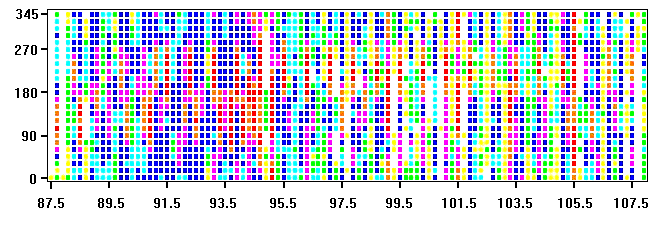
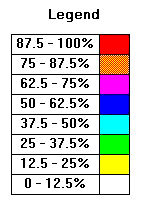
I chose to monitor CHTZ-FM (St. Catherines, Ontario) on 97.7 MHz for the following reasons.
The following table and map show all FM radio stations on 97.7 MHz within 600 miles of my house.
| Station | Power(kW) | Distance(mi) | Bearing(deg) | Location |
| WCZX | 0.300 | 67 | 30 | NY Hyde Park |
| WVRT | 6.000 | 139 | 279 | PA Jersey Shore |
| WCTY | 1.900 | 139 | 72 | CT Norwich |
| WAFL | 3.000 | 142 | 197 | DE Milford |
| WBKK | 1.600 | 147 | 9 | NY Amsterdam |
| WGMM | 1.300 | 152 | 305 | NY Big Flats |
| WGMM | 0.610 | 153 | 304 | NY Big Flats |
| WINQFM | 1.850 | 184 | 47 | MA Winchendon |
| WYAJ | 0.004 | 197 | 58 | MA Sudbury |
| WCAV | 3.000 | 203 | 66 | MA Brockton |
| WMDMFM | 3.300 | 206 | 209 | MD Lexington Park |
| WCAV | 2.700 | 208 | 65 | MA Brockton |
| WSGY | 3.500 | 241 | 255 | PA Somerset |
| WLERFM | 4.600 | 273 | 270 | PA Butler |
| CHTZFM | 50.000 | 282 | 302 | ON St Catharines |
| WGMT | 0.600 | 291 | 29 | VT Lyndon |
| CHOMFM | 41.000 | 324 | 9 | QU Montreal |
| WURB | 3.000 | 355 | 200 | NC Windsor |
| WILEFM | 1.800 | 372 | 260 | OH Byesville |
| WRONFM | 1.000 | 378 | 235 | WV Ronceverte |
| WAKN | 50.000 | 418 | 53 | ME Winter Harbor |
| WZBR | 3.000 | 420 | 201 | NC Kinston |
| WGGN | 0.640 | 424 | 274 | OH Castalia |
| WCJO | 3.000 | 439 | 252 | OH Jackson |
| WTGVFM | 3.000 | 453 | 292 | MI Sandusky |
| WMJD | 2.800 | 470 | 237 | VA Grundy |
| WTGN | 6.000 | 495 | 269 | OH Lima |
| WAXZ | 2.100 | 504 | 253 | OH Georgetown |
| WCXU | 20.000 | 528 | 40 | ME Caribou |
| WOXY | 3.000 | 542 | 259 | OH Oxford |
| WMRXFM | 2.000 | 544 | 291 | MI Beaverton |
| WMRXFM | 4.100 | 544 | 291 | MI Beaverton |
| WWXM | 100.000 | 558 | 204 | SC Georgetown |
| WZOW | 2.900 | 587 | 274 | IN Goshen |
| CKWMFM | 18.000 | 589 | 60 | NS Kentville |
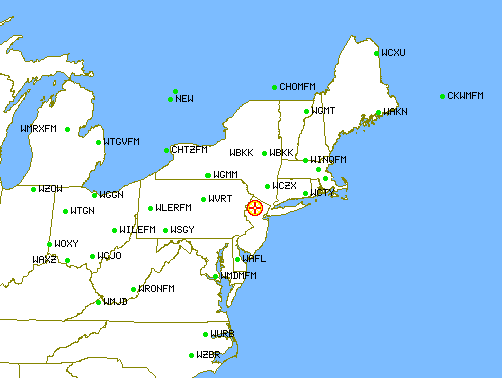
A Yagi type directional antenna (Radio Shack 15-2163 High Gain FM-stereo antenna) was used to reduce local interference and increase the intensity of the meteor scatter signal. The antenna was mounted on the roof of our house on a rotor (Radio Shack 15-1225 Antenna Rotor) so that it could be pointed in any direction. The antenna was connected to a sensitive (1.55 mV) FM radio (Yamaha TX-480 FM tuner). This radio was selected because it had a signal strength meter. The voltage from the signal strength meter was connected to an analog-digital converter. A computer recorded the digital signal strength from the analog-digital converter at one second intervals for later analysis. My father has prepared a page with more technical details.
Data Collection and Analysis
Both the 1998 Leonid and Geminid meteor showers showed significant activity at their peaks as compared to the background rate of sporadic meteors of 3 - 5 meteors per hour. Since a characteristic of meteor scatter is a rapid rise in signal strength above the background noise, the activity rates were determined by a computer program that counted as meteor signals all peaks with an initial rise greater than 20% of the background in one second. This criterion was selective enough to prevent noise signals from being counted as meteors while still allowing an accurate counting of meteors during very active periods.
1998 Leonid and Geminid Data
The following are examples of the raw data for the 1998 Leonid meteor shower. These charts are signal traces of one hour duration beginning at the specified hour. Each horizontal strip is 15 minutes. The first chart shows the signals a few hours before the peak. The second chart shows the signals near the peak. The last chart shows the signals a few hours after the peak. It is easy to see that there are many more signal peaks during the meteor shower than before or after.
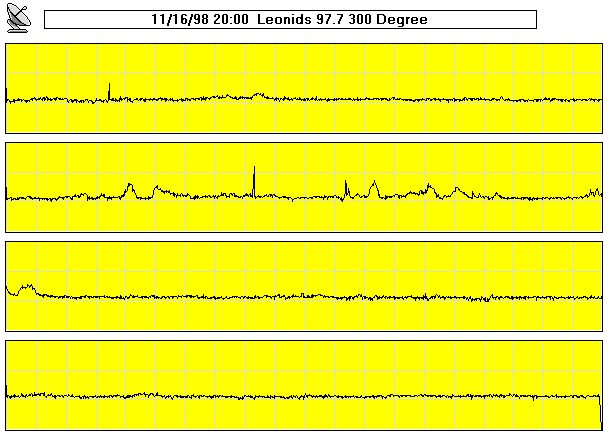
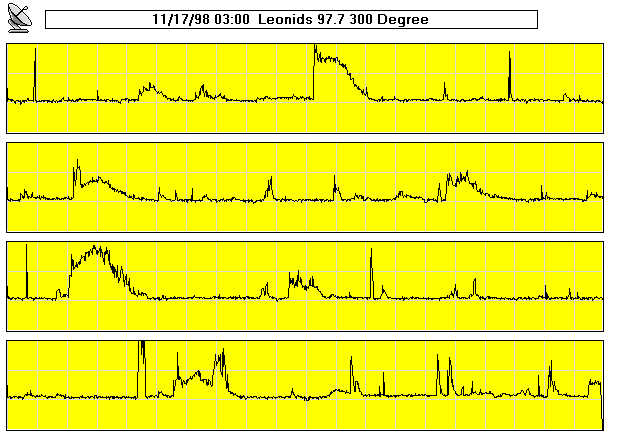
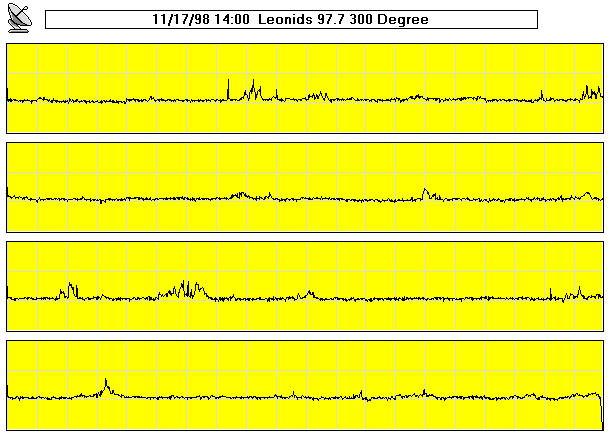
Rates for 1998 Leonids and Geminids
The following graphs show the meteor count rates per hour that I measured for the 1998 Leonids and Geminids. These rates were determined by a computer program that counted all peaks that climbed at least 20% above the background level in one second.
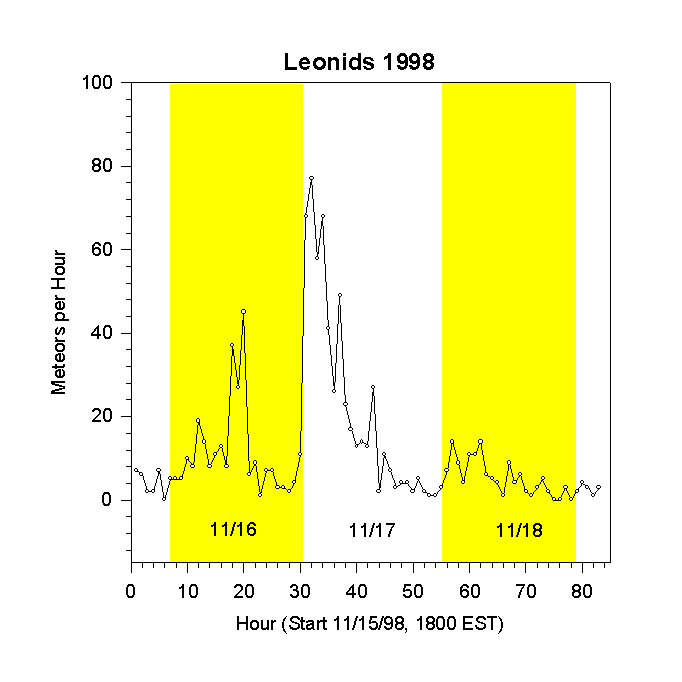
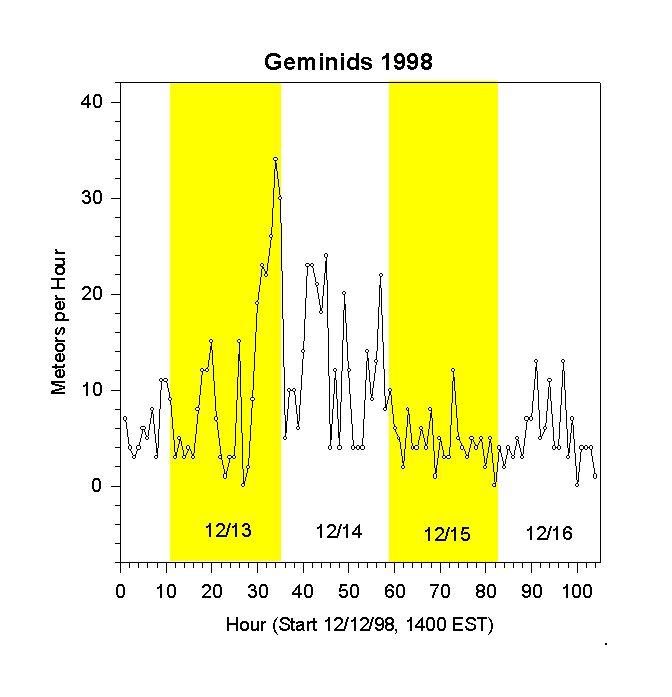
Summary and Conclusions
The peak intensity of the Leonid meteor shower occurred at 1:00 AM on November 17, 1998. The peak rate was about 80 meteors per hour, significantly less than the predictions. The peak intensity of the Geminid meteor shower occurred at 11:00 PM on December 13, 1998. The peak rate was about 35 meteors per hour, which is the typical rate for the Geminid meteor shower. The Leonids peaked sharply over the course of a few hours, but the Geminid shower peak occurred over a two day period.
Glossary and Further Information
Bibliography and Links
"FM Radio Station Search," http://radiostation.com.
Gebhardt, Philip, "Observing Meteors on Your FM Dial," Sky and Telescope, December 1997, pp. 108-111.
Gebhardt, Philip, "Radio Detection of Meteors," http://www.odxa.on.ca/meteor.html.
International Meteor Organization, http://www.imo.net/.
Jet Propulsion Laboratory, "Meteor Streams," http://ssd.jpl.nasa.gov/meteor_streams.html.
"Búsqueda de Meteoros por Radio," Radio Meteor Web Site (in Spanish) by Federico Pfaffendorf, http://radiometeoro.8m.com.
Radio Meteor Observation, Hiroshi Ogawa, Unviersity of Tsukuba, Japan, http://homepage2.nifty.com/~baron/.
Struve, Otto, "Meteors," Chapter 14 of Elementary Astronomy (New York: Oxford University Press), 1959.
Wyatt, Stanley P., Principles of Astronomy (Boston: Allyn & Bacon, Inc.), 1969.
See my other science fair project Speed of Sound in Gases .
Comments and technical questions can be addressed to me care of my father, Devlin Gualtieri, at Honeywell Laboratory, Morristown, NJ.